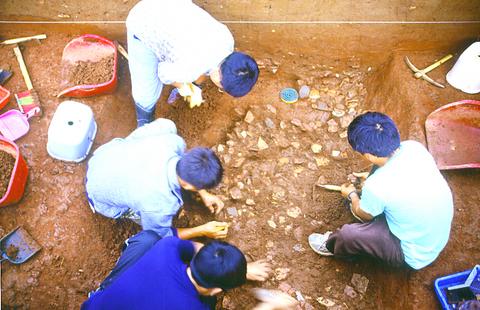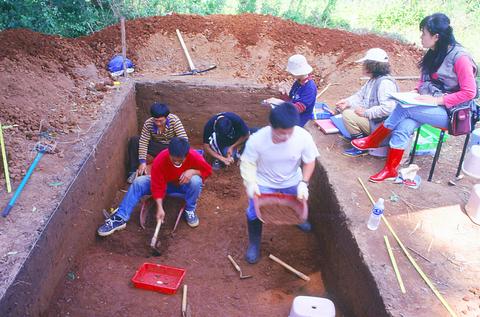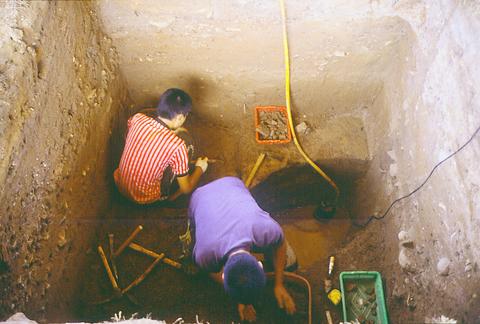It might have created little media attention, but the display of ancient artifacts excavated by the Historical Archeology Team (HAT, 歷史考古小組) from sites in Hualien and Kinmen, which is currently on show at Taipei's National Museum of History (國立歷史博物館), is a milestone for local historians and archeologists alike.
While the 250 pieces that comprise the exhibition are only a very small percentage of the total amount unearthed by the group, it is hoped that the collection will be enough to spark public interest in a field of historical detection that is still misunderstood by much of Taiwan's populace.
"Until the director put the idea forward to form a group of experts to excavate historical sites, non-academic archeology in Taiwan was nearly non-existent," stated HAT's Chai Chen-hsiao (

PHOTO COURTESY OF THE HISTORICAL ARCHEOLOGY TEAM
Established on the recommendation of the director of the National Museum of History, Huang Kuang-nan (黃光男), and jointly funded by the museum and the Ministry of Education, HAT is the first nationally funded group to be established with the aim of locating and excavating the multitude of proven and suspected archeological sites that dot Taiwan.
Preceding the establishment of the team, which includes archeologists, historians and anthropologists, a vast majority of the archeological digs that took place in Taiwan were undertaken by two of the nation's leading institutes of higher education.
Over the years, members of the anthropology and archeological institutes of Academia Sinica (中央研究院) and National Taiwan University (國立台灣大學) have discovered a total of 179 sites of historical interest throughout Taiwan and its outlying islands. This number, however, is only a fraction of the more than 1,000 sites believed worthy of excavation.

"There are reportedly over 1,000 sites in Taiwan where experts predict that substantial finds of historical significance could be unearthed," said Chiang Kuei-chen (江桂珍), anthropologist and fellow member of HAT. "Some of these we know about because of their mention in historical tomes and others because residents of the areas have regularly reported the finding of ancient artifacts to the authorities. Of course, in addition to these, there are probably plenty of other sites we don't know about."
After spending months in Hualien early last year, where the newly formed team trained and honed its archeology skills at an already well established and extensively surveyed site, it was decided that the team's inaugural dig take place in an area where Taiwan's earliest cultural influences came ashore.
Sending an advance party to Kinmen in April last year in order to survey suspected areas of historical value, the group finally began excavations at three sites in July of 2001. The team settled for sites located in the towns of Shuitou (水頭), Chunglin (瓊林) and Kuanou (官澳) for its inaugural digs.

"We decided on Kinmen because of its historical significance. It was one of the first places in what is present-day Taiwan to be influenced by the people and culture of Southwest China," Chai explained. "Because of this, Kinmen boasts a multitude of possible sites worthy of archeological exploration."
The group spent almost a month on Kinmen and exhumed upwards of 20,000 artifacts of historical value from over a dozen plots scattered throughout the three townships.
The relics, or rather fragments of what were once household wares and the remains of food stuffs, included plates, bowls and urns as well as glazed pottery and large numbers of animal bones and shells.
While much of what was unearthed during the group's excavations on Kinmen dated from the Song dynasty (
The extensive digs on Kinmen might not have yielded any breakthrough finds, but they did provide strong evidence apropos the close historical relationship between Southeast China and Kinmen.
"Obviously we don't expect to find anything that will rewrite our history books, nor do we expect to come across any breathtaking and unblemished finds," Chiang said. "But the artifacts we did unearth certainly lead us to believe that Kinmen is a crucial cog in Taiwan's overall cultural history."
While it is hoped that the team's continued findings will lead to a better understanding of the cultural origins of the peoples of Taiwan, the task set before them will certainly not be completed overnight.
Because the team currently consists of only seven members, surveys and excavations -- not to mention the collating of results -- are proving lengthy affairs. And, according to Chang, things will probably slow down even more if public interest and academic support wane.
"While we could obviously do with more members, seven is okay to have present at a dig. It gets a bit messy and out of hand the more people you have trampling around," Chiang said. "I can imagine that it will be the slow axing of our annual budget that will finally bring the curtain down on the whole affair. I'm sure we're pretty near the bottom of all the national funding lists."
It's not only a question of cash, however. In addition to funds, the sluggish pace of excavating and cataloging of results is supplemented by the fact that the group's work remains a part-time venture.
Between April and May this year the group traveled to Penghu and excavated two sites. The thousands of artifacts unearthed during the month-long dig are still packed in plastic crates waiting for cleaning, classification and cataloging nearly six months after excavation.
"I guess, or rather I hope, we'll get around to sorting it all out sometime this year," Chiang said. "But as we all hold full-time positions with academic institutes, finding the time to get together to do this will, no doubt, prove a more painstaking problem than actually digging the holes in the ground."
It's not all bad news for HAT, though. While the problems with funding and work schedules continue to hamper the team's capacity to pursue its task of unearthing Taiwan's long-buried past, its members remain optimistic.
Plans are already being drawn up for next year's dig, which at present looks set to take place in either Tainan or Penghu.

Most heroes are remembered for the battles they fought. Taiwan’s Black Bat Squadron is remembered for flying into Chinese airspace 838 times between 1953 and 1967, and for the 148 men whose sacrifice bought the intelligence that kept Taiwan secure. Two-thirds of the squadron died carrying out missions most people wouldn’t learn about for another 40 years. The squadron lost 15 aircraft and 148 crew members over those 14 years, making it the deadliest unit in Taiwan’s military history by casualty rate. They flew at night, often at low altitudes, straight into some of the most heavily defended airspace in Asia.

Taiwan’s democracy is at risk. Be very alarmed. This is not a drill. The current constitutional crisis progressed slowly, then suddenly. Political tensions, partisan hostility and emotions are all running high right when cool heads and calm negotiation are most needed. Oxford defines brinkmanship as: “The art or practice of pursuing a dangerous policy to the limits of safety before stopping, especially in politics.” It says the term comes from a quote from a 1956 Cold War interview with then-American Secretary of State John Foster Dulles, when he said: ‘The ability to get to the verge without getting into the war is

Beijing’s ironic, abusive tantrums aimed at Japan since Japanese Prime Minister Sanae Takaichi publicly stated that a Taiwan contingency would be an existential crisis for Japan, have revealed for all the world to see that the People’s Republic of China (PRC) lusts after Okinawa. We all owe Takaichi a debt of thanks for getting the PRC to make that public. The PRC and its netizens, taking their cue from the Chinese Communist Party (CCP), are presenting Okinawa by mirroring the claims about Taiwan. Official PRC propaganda organs began to wax lyrical about Okinawa’s “unsettled status” beginning last month. A Global

Like much in the world today, theater has experienced major disruptions over the six years since COVID-19. The pandemic, the war in Ukraine and social media have created a new normal of geopolitical and information uncertainty, and the performing arts are not immune to these effects. “Ten years ago people wanted to come to the theater to engage with important issues, but now the Internet allows them to engage with those issues powerfully and immediately,” said Faith Tan, programming director of the Esplanade in Singapore, speaking last week in Japan. “One reaction to unpredictability has been a renewed emphasis on